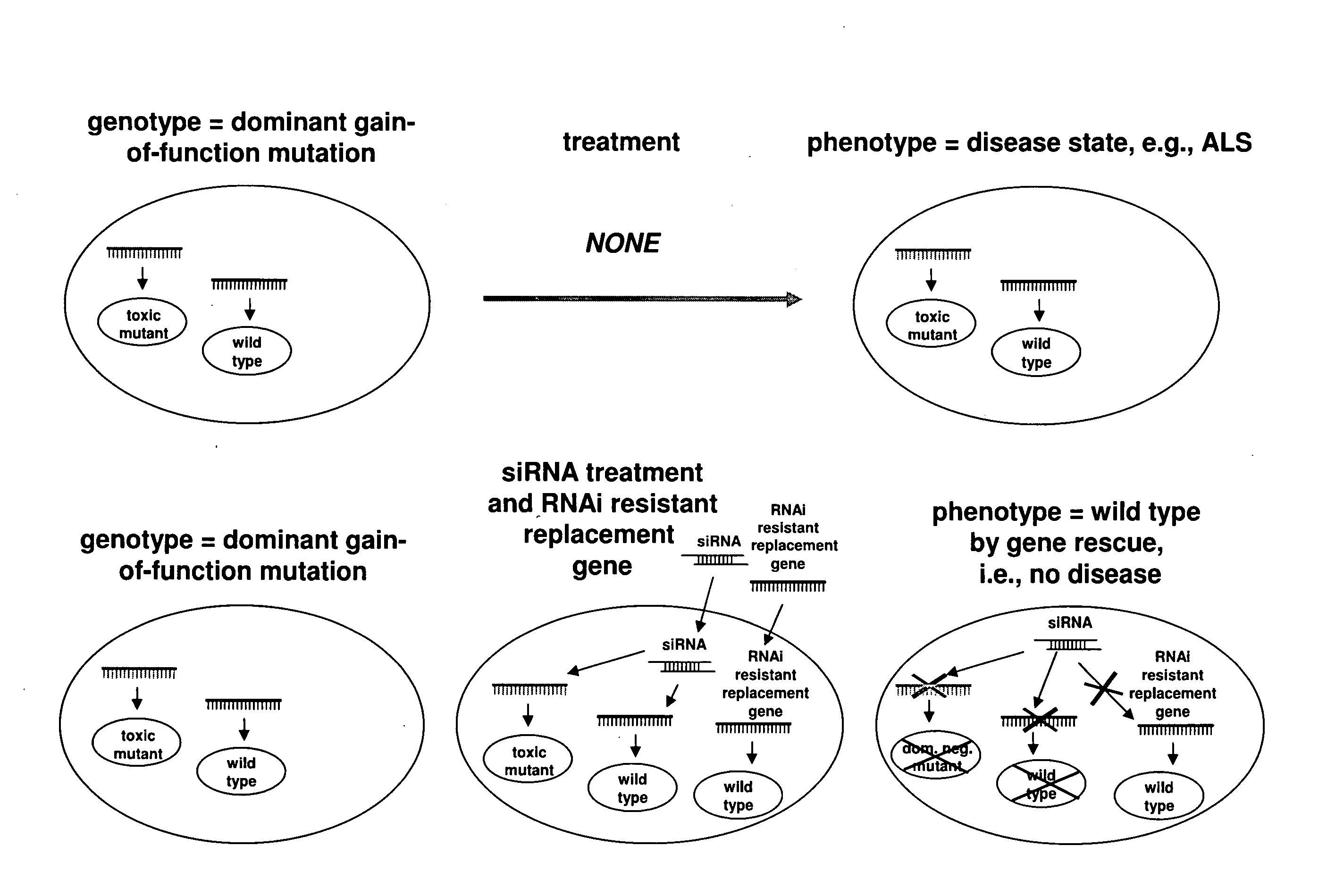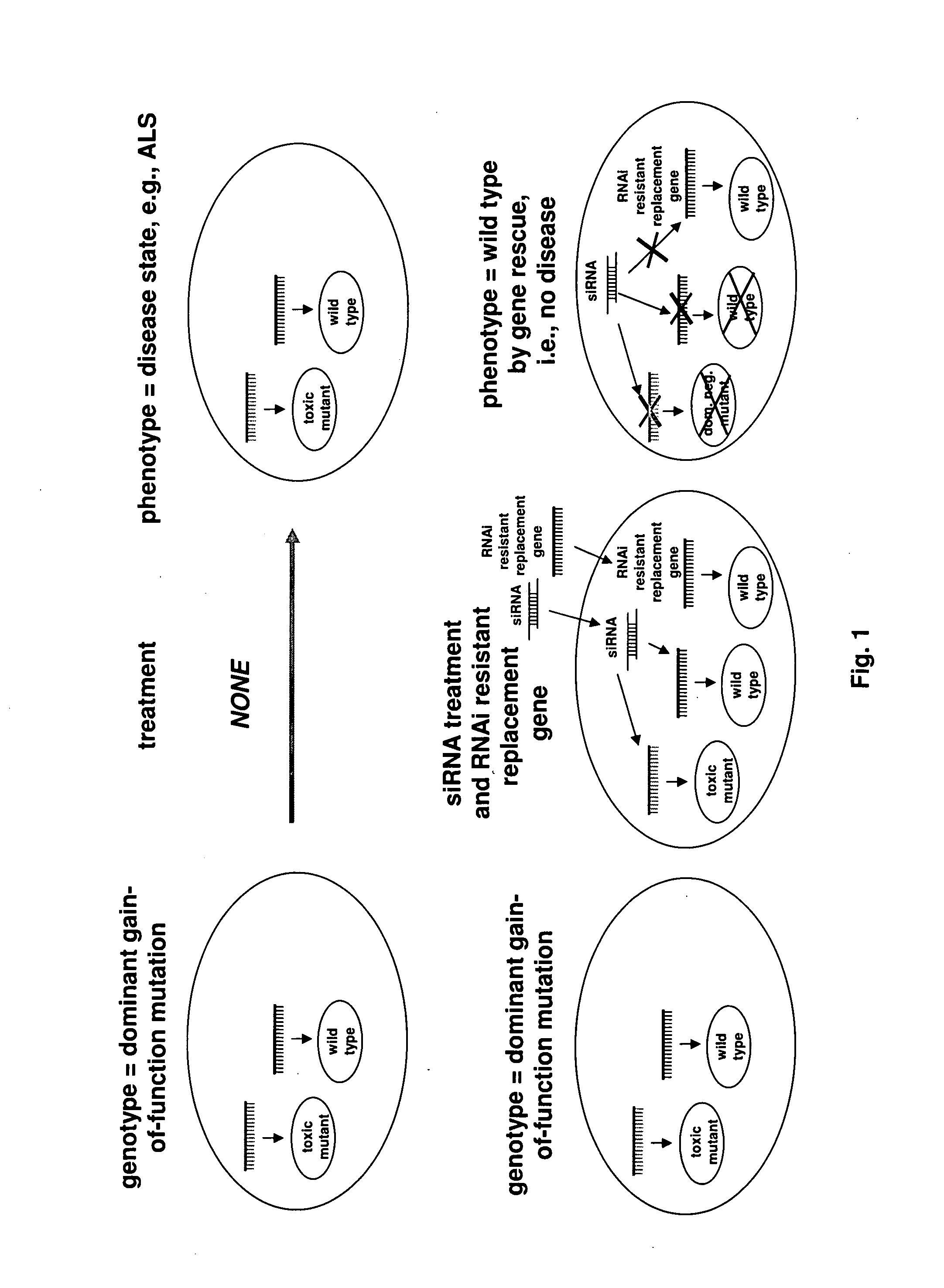Methods and compositions for treating gain-of-function disorders using RNA interference
a gain-of-function disorder and rna interference technology, applied in the direction of drug compositions, genetic material ingredients, artificial cell constructs, etc., can solve the problem that the complementarity of the antisense strand sequence is not sufficient to direct rnai, and achieve the effect of effective treatment of the diseas
- Summary
- Abstract
- Description
- Claims
- Application Information
AI Technical Summary
Benefits of technology
Problems solved by technology
Method used
Image
Examples
example 1
Generation of Optimal shRNA Sequences
[0199]Because more than one hundred SOD1 mutants cause ALS and the mutations are scattered throughout the entire coding sequence of SOD1, shRNAs targeting two different sequence regions are needed for silencing all mutants. To find the two optimal shRNAs, we constructed 8 shRNAs and tested them. To facilitate this test, we constructed a reporter construct, which consisted of firefly luciferase in the coding region and the entire SOD1 cDNA in the 3′ untranslated region (luc-SOD1).
[0200]Each of the eight candidate shRNA vectors (as well as one empty control vector) were separately cotransfected with the luc-SOD1 reporter construct into HEK293 cells. The silencing activity by each of the shRNAs was measured by the dual luciferase assay. (see FIG. 2A). The luciferase activity represents the ratio of firefly luciferase activity to renilla luciferase activity, which was normalized to the average ratio from the cells transfected with the blank shRNA vec...
example 2
Construction of SOD1 RNAi Resistant Replacement Genes
[0202]The following example describes methods for constructing an RNAi resistant rescue gene that expresses wild-type SOD1 in the presence of shRNA-induced silencing of a target allele.
[0203]The SOD1 RNAi resistant rescue gene i.e., hSOD1-1 and hSOD1-3 encodes the wild-type SOD1 with silent codon changes in the respective target regions of two SOD1 hairpins i.e., hSOD1hp-1 and hSOD1hp-3 (FIG. 3). The hSOD1-1 construct, GGAAACGTCACGGCGGATAAAG (sense stand; SEQ ID NO:3), contains 6 mismatched nucleotides (bold and underlined) against the hSOD1hp-1 target allele. The hSOD1-3 construct, GCAGACGTCAGTATAGAGGAC(sense strand; SEQ ID NO:8), contains 8 mismatched nucleotides (bold and underlined) against the hsSOD1-3 target allele.
[0204]Accordingly, hSOD1-1 and hSOD1-3 are resistant to shRNA-induced silencing by hSOD1hp-1 and hSOD1hp-3, respectively.
example 3
SOD1 RNAi Resistant Replacement Gene Resistant to shRNA Induced Silencing by shRNA-a and shRNA-b
[0205]To generate SOD1 RNAi-replacement genes that would resist cleavage by the potent shRNAs, of Example 1 (shRNA-a and shRNA-b) we created silent mutations in the cDNA sequence corresponding to the mRNA target site of shRNA-a (5′-GCAAUGUGACUGCUGACAAAG-3′, SEQ ID NO: 83) and shRNA-b (5′-GCCGAUGUGUCUAUUGAAGAU-3′; SEQ ID NO:84). We generated SOD1a, an RNAi-resistant replacement gene encoding a target mRNA sequence (5′-GCAACGUAACGGCUGACAAAG-3′; SEQ ID NO:85) having 3 mismatches, and SOD1b, an RNAi-resistant replacement gene encoding a target mRNA (5′-GCCGACGUGAGUAUUGAAGAU; SEQ ID NO:86) having 3 mismatches (see FIG. 2B). Silent mutations of wildtype human SOD1 was generated using Quick-change Site-Directed Mutagenesis kit (Stratagene) to generate SOD1a and SOD1b.
[0206]The test resistance of the SOD1 RNAi resistant replacement gene against shRNA induced silencing, we generated GEP reporter g...
PUM
| Property | Measurement | Unit |
|---|---|---|
| survival time | aaaaa | aaaaa |
| pH | aaaaa | aaaaa |
| pH | aaaaa | aaaaa |
Abstract
Description
Claims
Application Information
 Login to View More
Login to View More - R&D
- Intellectual Property
- Life Sciences
- Materials
- Tech Scout
- Unparalleled Data Quality
- Higher Quality Content
- 60% Fewer Hallucinations
Browse by: Latest US Patents, China's latest patents, Technical Efficacy Thesaurus, Application Domain, Technology Topic, Popular Technical Reports.
© 2025 PatSnap. All rights reserved.Legal|Privacy policy|Modern Slavery Act Transparency Statement|Sitemap|About US| Contact US: help@patsnap.com



